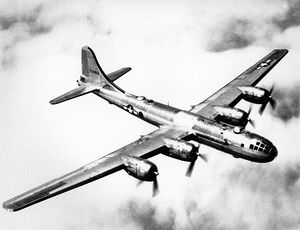World War II Aircraft
Military aircraft in World War II included bombers, fighters, and reconnaissance airplanes, as well as a limited number of cargo transports, gliders, blimps, and even jets. Aircraft of various kinds had played a highly visible, but relatively minor role in World War I, but during World War II they were arguably the most important weapons delivery system.
Both the primary aggressors in the war, Germany and Japan, launched their campaigns with heavy air strikes. The German Luftwaffe, or air force, used fighters and dive-bombers to overrun Denmark and Holland early in the war, as a prelude to their capture of France. Fighters such as the Messerschmitt BF-109 and the Focke Wulf 190 proved to be formidable weapons. Then, improved bombers rained bombs on England in an attempt to knock this enemy out of the war. The British responded with advanced fighters such as the famous Spitfire, which was guided by the new technology of radar. This was the Battle of Britain, a conflict fought entirely in the air and which forced a radical change in Germany’s war plans when they found themselves unable to dominate the British skies. Japan also inaugurated its war on the U.S with an air attack. The Japanese used aircraft carriers, which had been in service since the 1920s in the famous Japanese surprise attack on Pearl Harbor, Hawaii, which destroyed most of the U.S Pacific fleet using aircraft almost exclusively.
Technologically, military aircraft rapidly evolved during the war. The wood-and-fabric biplanes of the Great War were superseded by sleek aluminum airframes with powerful, often supercharged piston engines. While the British had the Spitfire and the Germans the Messerschmitt, the U.S made innovations as well, developing the successful P-51 Mustang in collaboration with the British, and introducing important innovations in long-range bombers, such as the B-17 “Flying Fortress” and the famous B-29.
Radically new types of aircraft also emerged. The Germans, English, and Americans began to experiment with jet-powered aircraft, with the Germans and British actually flying some combat missions in them. These new aircraft achieved very high speeds using the jet engine, a new type of engine that had no propellers. The Germans, and, to a lesser extent, the Americans even developed pilotless, guided missiles during the war, such as Germany’s V1 and V2 weapons. However, the bulk of aerial combat was conducted using propeller-driven, human-piloted fighters and bombers.
Over the course of the war, many important battles took place on land and at sea, but it is significant that many of the closing events of the war also depended on aircraft. Once the Allies began retaking territory in Europe, heavy bombers began to attack within Germany. By destroying much of its ability to produce fuel and munitions, bombers turned the tide on the German war effort.
Finally, the large bombers developed late in the war, such as the B-29 were huge craft capable of delivering atomic bombs nearly anywhere in the world. The U.S used a B-29 called the Enola Gay in its final airborne attack—dropping the atomic bomb on Japan. By the end of the war in 1945, fighters and bombers had been transformed into highly effective weapons systems. Today’s fighters and bombers use jet engines and remain central to military forces around the world.
